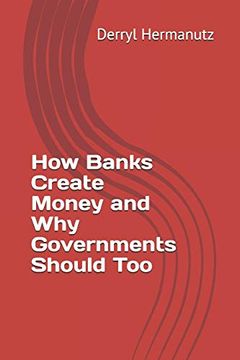Reseña del libro "How Banks Create Money and why Governments Should too (en Inglés)"
Where does money come from?Why is there so much debt?Every government on Earth is a billionaire or trillionaire bond debtor, not a rich as Midas money printer. Everybody knows that. In the Fifty Years Ago Today section of daily newspapers, headlines warn of alarming and increasing levels of government deficits and debts. Government-issued debt is front page news, everywhere, and has been for a very long time. Yet most people continue to believe the government issues the money."There are three main types of money: currency, bank deposits, and central bank reserves. ...Most money in the modern economy is in the form of bank deposits, which are created by commercial banks themselves." {Bank of England, Money in the Modern Economy (2014)}Private commercial banks - not governments; not central banks - issue the money supply of nations by lending it into existence. Commercial banks create money in the form of bank deposits - spendable bank deposit account balances, in borrowers' bank deposit accounts. People, businesses and governments who borrow and spend money that is created by banks are "debtors" who owe the borrowed money back to the banks.Debtors pay the new balances to payees - by check, direct deposit, online banking, debit card, etc - within the central-commercial bank-operated payments system of debiting payer accounts and crediting payee accounts.The new balances are debited out of the debtors' bank deposit accounts and credited into the first payees' bank deposit accounts.That's where the deposit account money supply - the spendable, investible, savable (and cashable) balances in our bank deposit accounts - comes from, in the first place. Then payees create the spendable cash money supply when we make cash withdrawals, and pay with debits to our deposit account balances.But most bank deposits are never cashed out. Most money never exists in any other form than balances in payees' bank deposit accounts.Debtors owe all the deposit account money balances back to their banks as payment of the debtors' loan account and bond debt balances.Repaying a bank loan un-creates - extinguishes; cancels out to $0/$0 - the deposit account money balance, and the loan or bond account debt balance, that were created by making the bank loan or bond purchase.The deposit account money supply - which is about 97% of all money that exists - only exists so long as debtors' debts remain unpaid.But debtors can't pay their loan account and bond debts because payees have all the deposit account money; which we are using as our spendable, investible, savable "money supply".The commercial banks' "repayable bank loan and bond purchase" money supply creation monopoly systematically creates unpayable debts.The banks' debt-based money system creates ever-increasing totals of payees' bank deposit account balances that are owed back to banks as payment of debtors' ever-increasing totals of unpayable loan account and bond debt balances; until debtors finally default en masse and the banking system descends into a financial crisis of creditors' uncollectable money owed as debtors' unpayable debts.This booklet describes how commercial banks create the spendable money supply; how central banks create the base money supply; and how the money-using people, businesses and governments of the world sink into ever-deeper pits of unpayable debt bondage.It doesn't have to be this way.Seeing how the banks' debt-based money creation monopoly works, exposes why it fails, and illuminates the technically simple way to fix it: add debt-free government-issued "helicopter money" into the banks' debt-based money supply.Ben Franklin's colonial government did it. Abraham Lincoln's Civil War government did it. We can do it too.

